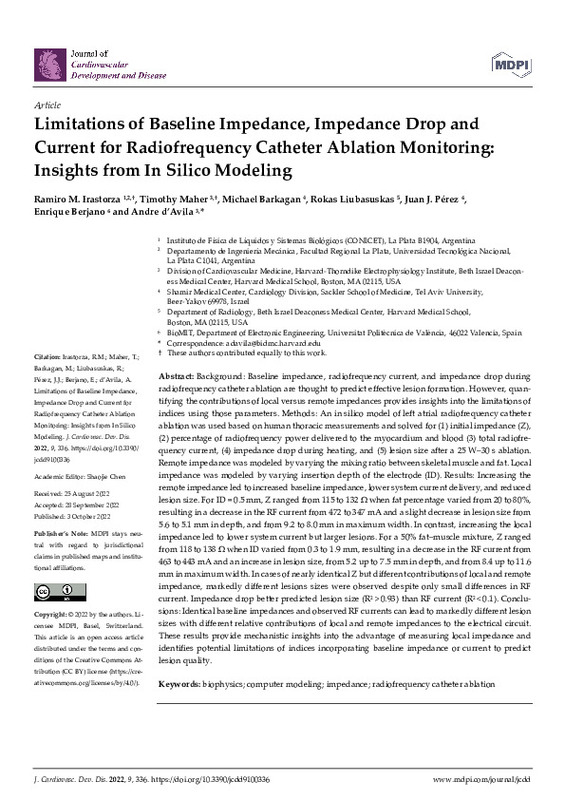JavaScript is disabled for your browser. Some features of this site may not work without it.
Buscar en RiuNet
Listar
Mi cuenta
Estadísticas
Ayuda RiuNet
Admin. UPV
Limitations of Baseline Impedance, Impedance Drop and Current for Radiofrequency Catheter Ablation Monitoring: Insights from In Silico Modeling
Mostrar el registro sencillo del ítem
Ficheros en el ítem
| dc.contributor.author | Irastorza, Ramiro M.
|
es_ES |
| dc.contributor.author | Maher, Timothy
|
es_ES |
| dc.contributor.author | Barkagan, Michael
|
es_ES |
| dc.contributor.author | Liubasuskas, Rokas
|
es_ES |
| dc.contributor.author | Pérez, Juan J
|
es_ES |
| dc.contributor.author | Berjano, Enrique
|
es_ES |
| dc.contributor.author | D Avila, Andre
|
es_ES |
| dc.date.accessioned | 2022-10-21T18:03:21Z | |
| dc.date.available | 2022-10-21T18:03:21Z | |
| dc.date.issued | 2022-10-03 | es_ES |
| dc.identifier.uri | http://hdl.handle.net/10251/188559 | |
| dc.description.abstract | [EN] Background: Baseline impedance, radiofrequency current, and impedance drop during radiofrequency catheter ablation are thought to predict effective lesion formation. However, quantifying the contributions of local versus remote impedances provides insights into the limitations of indices using those parameters. Methods: An in silico model of left atrial radiofrequency catheter ablation was used based on human thoracic measurements and solved for (1) initial impedance (Z), (2) percentage of radiofrequency power delivered to the myocardium and blood (3) total radiofrequency current, (4) impedance drop during heating, and (5) lesion size after a 25 W¿30 s ablation. Remote impedance was modeled by varying the mixing ratio between skeletal muscle and fat. Local impedance was modeled by varying insertion depth of the electrode (ID). Results: Increasing the remote impedance led to increased baseline impedance, lower system current delivery, and reduced lesion size. For ID = 0.5 mm, Z ranged from 115 to 132 ¿ when fat percentage varied from 20 to 80%, resulting in a decrease in the RF current from 472 to 347 mA and a slight decrease in lesion size from 5.6 to 5.1 mm in depth, and from 9.2 to 8.0 mm in maximum width. In contrast, increasing the local impedance led to lower system current but larger lesions. For a 50% fat¿muscle mixture, Z ranged from 118 to 138 ¿ when ID varied from 0.3 to 1.9 mm, resulting in a decrease in the RF current from 463 to 443 mA and an increase in lesion size, from 5.2 up to 7.5 mm in depth, and from 8.4 up to 11.6 mm in maximum width. In cases of nearly identical Z but different contributions of local and remote impedance, markedly different lesions sizes were observed despite only small differences in RF current. Impedance drop better predicted lesion size (R2 > 0.93) than RF current (R2 < 0.1). Conclusions: Identical baseline impedances and observed RF currents can lead to markedly different lesion sizes with different relative contributions of local and remote impedances to the electrical circuit. These results provide mechanistic insights into the advantage of measuring local impedance and identifies potential limitations of indices incorporating baseline impedance or current to predict lesion quality | es_ES |
| dc.description.sponsorship | Spanish Ministerio de Ciencia, Innovación y Universidades / Agencia Estatal de Investigación (MCIN/AEI/10.13039/501100011033) under grant RTI2018-094357-B-C21, and Agencia Nacional de Promoción Científica y Tecnológica de Argentina, grant PICT-2016-2303. Dr. Irastorza was the recipient of a scholarship of the Programa de Becas Externas Postdoctorales para Jóvenes Investigadores del CONICET (Argentina). | es_ES |
| dc.language | Inglés | es_ES |
| dc.publisher | MDPI AG | es_ES |
| dc.relation.ispartof | Journal of Cardiovascular Development and Disease | es_ES |
| dc.rights | Reconocimiento (by) | es_ES |
| dc.subject | Biophysics | es_ES |
| dc.subject | Computer modeling | es_ES |
| dc.subject | Impedance | es_ES |
| dc.subject | Radiofrequency catheter ablation | es_ES |
| dc.subject.classification | TECNOLOGIA ELECTRONICA | es_ES |
| dc.title | Limitations of Baseline Impedance, Impedance Drop and Current for Radiofrequency Catheter Ablation Monitoring: Insights from In Silico Modeling | es_ES |
| dc.type | Artículo | es_ES |
| dc.identifier.doi | 10.3390/jcdd9100336 | es_ES |
| dc.relation.projectID | info:eu-repo/grantAgreement/AEI/Plan Estatal de Investigación Científica y Técnica y de Innovación 2017-2020/RTI2018-094357-B-C21/ES/MODELADO Y EXPERIMENTACION PARA TERAPIAS ABLATIVAS INNOVADORAS/ | es_ES |
| dc.relation.projectID | info:eu-repo/grantAgreement/ANPCyT//PICT-2016-2303/ | es_ES |
| dc.rights.accessRights | Abierto | es_ES |
| dc.contributor.affiliation | Universitat Politècnica de València. Departamento de Ingeniería Electrónica - Departament d'Enginyeria Electrònica | es_ES |
| dc.description.bibliographicCitation | Irastorza, RM.; Maher, T.; Barkagan, M.; Liubasuskas, R.; Pérez, JJ.; Berjano, E.; D Avila, A. (2022). Limitations of Baseline Impedance, Impedance Drop and Current for Radiofrequency Catheter Ablation Monitoring: Insights from In Silico Modeling. Journal of Cardiovascular Development and Disease. 9(10):1-12. https://doi.org/10.3390/jcdd9100336 | es_ES |
| dc.description.accrualMethod | S | es_ES |
| dc.relation.publisherversion | https://doi.org/10.3390/jcdd9100336 | es_ES |
| dc.description.upvformatpinicio | 1 | es_ES |
| dc.description.upvformatpfin | 12 | es_ES |
| dc.type.version | info:eu-repo/semantics/publishedVersion | es_ES |
| dc.description.volume | 9 | es_ES |
| dc.description.issue | 10 | es_ES |
| dc.identifier.eissn | 2308-3425 | es_ES |
| dc.relation.pasarela | S\472706 | es_ES |
| dc.contributor.funder | AGENCIA ESTATAL DE INVESTIGACION | es_ES |
| dc.contributor.funder | Agencia Nacional de Promoción Científica y Tecnológica, Argentina | es_ES |
| upv.costeAPC | 1386,72 | es_ES |








